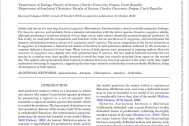Obsah
Adults and larvae of a true bug, Scantius aegyptius (Heteroptera: Pyrrhocoridae), closely resemble sympatric firebugs, Pyrrhocoris apterus, and probably form a mimetic relationship with the latter species. Scantius aegyptius adults, although producing a secretion atypical of true bugs, are to some extent chemically protected against predators. In this study, we analysed the composition and function of the larval secretion in S. aegyptius, and investigated the mimetic relationship between larvae of S. aegyptius and P. apterus. The main component of the larval secretion in S. aegyptius is 2-heptanol, a chemical not known to function in anti-predatory defence, followed by (E)-2-octenal, a common defensive chemical of true bugs. When larvae of both species were presented to jumping spiders (Evarcha arcuata), S. aegyptius was slightly less well protected than P. apterus, but the spiders behaved towards the two species in a similar way: they quickly learned to avoid the bugs, but usually attacked them again on the second day. The spiders also generalized their learned avoidance from one true bug species to the other (with only slight asymmetry favouring S. aegyptius), suggesting that the bugs’ mimetic relationship is most probably Müllerian, being advantageous to both species.



